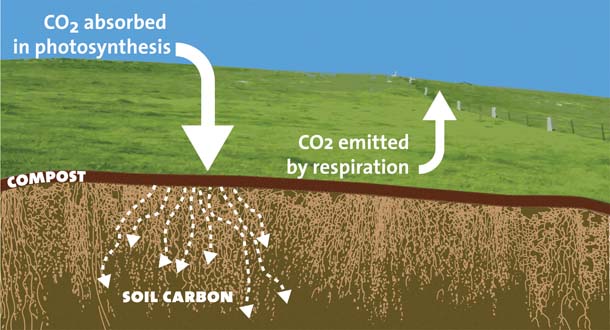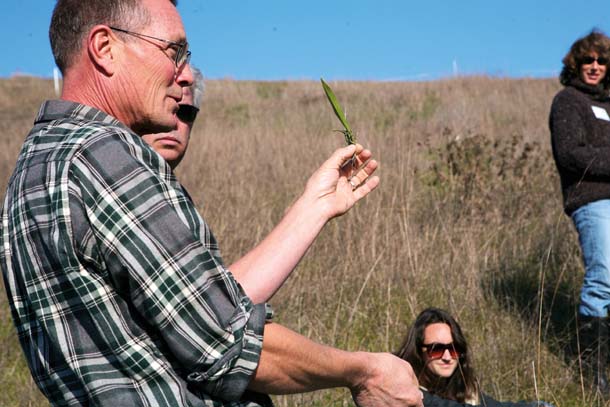On a windswept ranch above the tiny West Marin town of Nicasio, a man in a worn Carhartt jacket holds up a blade of grass with a triumphant smile. This is rancher and philanthropist John Wick, and he’s explaining how he hopes to help save the world using an unexpected tool: dirt.
Specifically, Wick and his partners at the Marin Carbon Project think that if ranchers make a few simple changes to their ranching practices, then massive amounts of greenhouse gases could be removed from the air and stored in the soil of their pastures. For a long, long time.
In an era marked by mounting greenhouse gases yet few practical solutions, the idea of sequestering carbon in the soil is so simple it sounds too good to be true. Soils have long been known to be one of the world’s largest pools of carbon. Yet when we think of places to store carbon, we tend to picture dense forests–not open grasslands–as the ideal landscape type. It’s time to think again.
The possibility that restoring grassland soils could serve to capture atmospheric carbon on a similar scale as planting trees was largely theoretical until 2007, when Wick and rangeland ecologist Jeff Creque first discussed it. They invited top UC Berkeley biogeochemist Whendee Silver to do a quantitative study, and within months the Marin Carbon Project was born, with Wick volunteering his ranch for the experiments. Members of the team include the USDA Natural Resources Conservation Service, Marin Organic, and the Marin Agricultural Land Trust.
- Rancher John Wick talks about the Marin Carbon Project to a group of climate change researchers and agency officials on a site visit at his ranch in Nicasio. Photo by Tom Forster, courtesy Marin Carbon Project
“People understand that agriculture produces greenhouse gases, but don’t realize that it can also be a big part of the solution,” says Torri Estrada, director of the project.
Four years in, the data emerging from the experiments is more clear-cut than anyone had expected. The main experiment began with spreading a single thin layer of organic compost on the test plots in a pasture–and the next year the soil had more carbon. And the next year, and the next.
“It’s pretty incredible,” says Silver. “[The amount of carbon] continues to grow more year after year. We basically have increased the production in the system up to a new level.”
Three years ago, the team spread a half-inch blanket of compost on the soil surface of the test plot. Today, 90 percent of that material remains on the surface, acting like a slow-release fertilizer and helping to build soil organic matter. And the underlying soil has gained a metric ton more carbon than similar areas nearby that were left alone. Some of this additional carbon came from the compost, and some is likely to have come from plant growth that was stimulated by the compost. The team’s computer models suggest that a single application of compost could lead to carbon storage for up to 30 years.
If this turns out to be true, spreading compost on half the 23 million acres of rangeland in California every three decades could offset all carbon emissions from all commercial and residential use. For good.
Down the road from Wick’s ranch, the experiment has been repeated in another field, volunteered by a local dairy rancher. From a distance, the pasture just looks like a pasture. A gate of fence posts and wire opens onto a field with low-cropped grass and scattered cow pies. But a closer look reveals the telltale signs of a field science experiment: There is a small solar-powered electrical box, and rectangular plots are marked with brightly colored tufts of flagging.
Look closer still, and you can clearly see the effects of the compost. Standing out on the green backdrop of the pasture are patches of darker green. The grass is kept short by the cows, but in some areas the plants clearly have glossier, broader leaves that are a deeper shade of green than their neighbors’. These are the places where compost was spread.
“We saw a big increase in forage production every year, and we saw a big increase in the roots too,” Silver says.
In other words, plant growth is very much connected to soil carbon storage. Each grass blade and iris leaf acts like a tiny vacuum, sucking carbon out of the air and transforming it into the solid structure of the plant’s body. The more the plants grow, the more carbon they need–and the less carbon is left in the atmosphere to contribute to climate change.

- Carbon dioxide absorbed by grasses through photosynthesis is sequestered in the roots and surrounding soil. The compost layer increases the amount of carbon absorbed by the plants, relative to the amount released back into the atmosphere. Illustration by Bay Nature, adapted from Whendee Silver, UC Berkeley,
Rangelands are an ideal place to store carbon because much of the grasses’ growth–and hence the initial carbon sequestration–is below the ground in the form of roots, where it can readily be transferred into more permanent storage in the soil. Trees and other plants also store carbon, but they grow more slowly. And they keep more of their biomass above the ground in the form of trunks, stems and leaves–where it is vulnerable to wildfire and human uses, which return stored carbon more quickly to the air.
Because most of our local (mostly nonnative) rangeland grasses grow quickly, produce lots of roots, and die every year, they are particularly good at pumping carbon into the soil. When a plant decomposes, the remnants of its roots and leaves stay in the soil, breaking into tiny particles. As those particles work their way into the soil, they get trapped, and the deeper they are, the longer they tend to stay. Some linger near the surface, where microbes turn the plant carbon back into a gas; but some get embedded in clumps of soil, where they can stay for decades. And some particles go deeper still and chemically bond with the soil. When that happens, the carbon can be trapped for centuries.
“When it gets deep into the soil it would take a fairly disruptive event–plowing, for example–to bring it out again,” says Estrada.
Every year the soil at the research plots is tested by taking core samples down to a meter below the surface. Portions of each sample are then put into tiny tin capsules and dropped into a high-tech furnace back at the lab at UC Berkeley. As the soil burns, sensors measure the amount of carbon released. And the findings? Consistently more carbon is present in the soils treated with compost. “It works–that’s the bottom line. The thing flies,” says Wick. “This is a success story.” Now the challenge is to scale it up and entice ranchers to join up by turning sequestration into a source of revenue for them.
Behind a dairy ranch on the outskirts of Nicasio, pile upon pile of compost stands in tidy rows. This project of the Marin Resources Conservation District is another arm of the Marin Carbon Project team’s work: blending local green waste and manure from nearby ranches to create the compost needed to expand a science experiment into a farming technique.
The compost is important not only because it helps the plants grow; simply creating it is good for the planet. Today, a lot of green waste, manure, and other organic material goes to landfills or into manure ponds on ranches. There it gradually decomposes under anaerobic conditions, actually becoming a source of the extremely potent greenhouse gas methane. Yet when the same material was spread on Wick’s ranch as compost, almost no greenhouse gases were released.
In fact, it turns out that those gases that don’t get generated in a landfill are the biggest benefit in the Marin Carbon Project’s carbon account book.
Getting ranchers to actually start spreading compost is the next goal of the project. “We hope to make that jump this year,” says Estrada. “Thus far it’s been a controlled experiment. Now we are looking at how to make this simple and easy to do so that the ranchers can really own it.”
“I think it’s a really good idea,” says Mike Giammona, a cattle rancher near Point Reyes Station. “The problem is the cost factor. Buying compost is really expensive; with what we get for running beef cattle, it’s not worth it right now financially.”
Providing financial incentive has been a goal of the Marin Carbon Project since the beginning. By developing a method through which soil carbon levels can not only be increased but also monitored, the project has been laying the groundwork to participate in emerging carbon markets. The project team is now working with the Environmental Defense Fund to develop a protocol that will meet state standards and let interested businesses and investors partner with rangeland owners on efforts to meet greenhouse gas reduction requirements.
But several hurdles remain. The protocol to verify how much carbon has been sequestered must be developed and approved. Then some organization or agency has to come forward with the staff to do the monitoring. Interested ranch managers need to be trained in the technique. And high-quality compost has to be made–a lot of it.
But the potential is significant. George Lucas’s Skywalker Ranch is one local business that proposes to offset 500 metric tons of greenhouse gas emissions per year. The hope is to account for much of that through rangeland carbon sequestration; several regulatory agencies are currently considering the proposal.
If the project can succeed in facilitating an economic reward for greenhouse gas reduction and carbon storage on California’s ranches, it will be an exciting step toward ensuring the preservation of iconic rural landscapes and communities. “The idea is that we would offer producers and landowners a suite of practices that have a carbon benefit,” says Estrada. “The endgame is to have a real impact on farms and on the climate.”
Learn more at marincarbonproject.org

.jpg)




